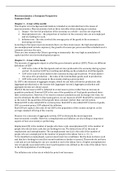Macroeconomics: a European Perspective
Summary book
Chapter 1 – A tour of the world:
This chapter is for background information, intended as an introduction to the issues of
macroeconomics. Macroeconomics look at three variables when studying an economy:
1. Output – the level of production of the economy as a whole – and its rate of growth;
2. Unemployment rate – the proportion of workers in the economy who are not employed
and are looking for a job;
3. Inflation rate – the rate at which the average price of the goods in the economy is
increasing over time.
According to European macroeconomists there are three main issues: the high unemployment
(no unemployment miracle anymore), the growth of income per person and the introduction of a
common currency: the euro.
There are two reasons why China is growing so immensely: the very high accumulation of
capital and the very fast technological progress.
Chapter 2 – A tour of the book:
The measure of aggregate output is called the gross domestic product (GDP). There are different
definitions of GDP:
• GDP is the value of the final goods and services produced in the economy during a given
period. à construct GDP by recording and adding up the production of all final goods.
• GDP is the sum of value added in the economy during a given period. à value added =
the value of its production – the value of the intermediate goods used in production.
• GDP is the sum of incomes in the economy during a given period.
So, GDP is the measure of aggregate output, which we can look at from the production side
(aggregate production) or the income side (aggregate income). Aggregate production and
aggregate income are always equal.
Much of the increase in GDP is reflected in an increase in prices rather than an increase in
quantities produced. Nominal GDP is the sum of the quantities of final goods produced times
their current prices. However, if we want to measure production and its change over time, we
need to eliminate the effect of increasing prices on our measure of GDP. Real GDP is constructed
as the sum of the quantities of final goods times constant (rather than current) prices.
Nominal GDP is also called GDP at current prices. Real GDP is also called GDP in terms of goods,
GDP at constant prices, GDP adjusted for inflation.
Real GDP per capita is the ratio of real GDP to the population of the country and gives us the
average standard of living of the country.
Because it is a measure of aggregate activity, GDP is obviously the most important
macroeconomic variable. However, unemployment and inflation are also telling us important
aspects of how an economy is performing.
Employment (N) is the number of people who have a job, unemployment (U) is the number of
people who do not have a job, but are looking for one. The labour force (F) is the sum of
employment and unemployment. The unemployment rate (u) is the ratio of the number of
people who are unemployed to the number of people in the labour force: u = U / L.
To be classified as unemployed, a person must meet two conditions: that he does not have a job
and that he is looking for one (this second condition is harder to assess). Those who do not have
a job and are not looking for one are counted as not in the labour force. A higher unemployment
rate is typically associated with a lower participation rate, defined as the ratio of the labour force
to the total population of working age.
The inflation rate is the rate at which the price level increases.
,GDP deflator: nominal GDP / real GDP. The GDP deflator is an index number à its rate of change
has a clear economic interpretation. Nominal GDP is equal to the GDP deflator times real GDP.
To measure the average price of consumption (the cost of living), we look at another index: the
consumer price index (CPI).
GDP looks at the average price of output (the goods produced), while CPI looks at the price of
goods consumed.
High deflation (a large negative rate of inflation) would create many of the same problems as
high inflation, from distortions to increased uncertainty. The best rate of inflation is a low and
stable rate of inflation, somewhere between 1 and 4%.
Okun’s law à if output growth is high, unemployment will decrease. An increase in the growth
rate of 1% leads to a decrease in unemployment by roughly -0.4% and it takes a growth rate of
about 3% to keep unemployment constant.
Phillips curve à when unemployment becomes very low, the economy is likely to overheat, and
this will lead to upward pressure on inflation.
Short run à year-to-year movements in output are primarily driven by movements in demand.
Medium run à the economy tends to return to the level of output determined by supply factors:
the capital stock, the level of technology and the size of the labour force.
Long run à we must look at factors like the education system, the saving rate and the role of the
government.
Chapter 3 – The Goods Market:
Changes in the demand for goods lead to changes in production à changes in production lead to
changes in income à changes in income lead to changes in the demand for goods.
GDP consists of different components:
• Consumption (C) à the goods and services purchased by consumers, by far the largest
component of GDP.
• Investment (I) à the purchase of new capital goods, such as new machines, buildings or
houses.
• Government spending (G) à the purchases of goods and services by the national,
regional and local governments.
• Imports (IM) and exports (EX) à subtract imports and add exports. The difference
between exports and imports is called net exports / trade balance and it can be a trade
surplus or a trade deficit.
• Inventory investment à the difference between production and sales, this is typically
small.
The total demand for goods = Z à Z = C + I + G – IM + EX. However, we make some
simplifications, for example that the economy is closed. So Z = C + I + G.
The disposable income (YD) is the income that remains once consumers have received
transfers from the government and paid their taxes.
C = C 0 + C 1Y D:
• C1 à gives the effect an additional dollar of disposable income has on consumption.
• C0 à what people would consume if their disposable income in the current year were
equal to zero. Consumption will always be positive: with or without income, people still
need to eat (they can do so by saving or borrowing).
Yd = Y – T, so à C = C0 + C1(Y-T).
Investment is an exogenous variable: taken as given. So I = I. We also take G and T as exogenous.
So Z + C + I + G à Z = C0 + C1(Y-T) + I + G.
, Equilibrium in the goods market: Y = Z (output is equal to demand) à Y = Z = C0 + C1(Y-T) + I +
G. in equilibrium, production (Y) is equal to demand. Demand in turn depends on income, Y,
which is itself equal to production.
We can rewrite the equilibrium equation:
Y = C0 + C1(Y-T) + I + G
Y = C o + C 1Y – C 1T + I + G
(1 – c1)Y = C0 + I + G – C1T
Y = – c1 (C0 + I + G – C1T)
Red is the part of the demand for goods that does
not depend on output: autonomous spending.
Blue is the multiplier, the closer it is to one, the
larger the multiplier.
à Any change in autonomous spending has the
same qualitative effect: it will change output by
more than its direct effect on autonomous spending.
(see figure 3.3, page 46).
Production depends on demand, which depends on
income, which is itself equal to production. An
increase in demand, such as an increase in
government spending, leads to an increase in
production and corresponding increase in income.
This increase in income leads to a further increase in
demand, which leads to a further increase in
production, and so on. The end result is an increase
in output that is larger than the initial shift in
demand by a factor equal to the multiplier. All these rounds happen at once: instantaneous
adjustment!
Private saving, saving by consumers, is equal to their disposable income – their consumption: S =
YD – C à S = Y – T – C. Public saving is equal to taxes minus government spending: T – G
(government budget surplus or budget deficit). à this leads to the equation that savings equal
investment: IS relation: what firms want to invest must be equal to what people and the
government want to save.
Chapter 4 – Financial Markets:
In the money market, you have the choice between two assets: money and bonds:
• Money: currency (coins and bills) and deposit accounts (the bank deposits on which you
can write cheques).
• Bonds à pay a positive interest rate (i), but cannot be used for transactions.
One should hold some money and bonds. But in what proportions? This depends on mainly two
variables:
• Level on transactions
• Interest rate on bonds à the only reason to hold bonds is that they pay interest. The
higher the interest rate, the more you will be willing to deal with the hassle and the costs
associated with buying and selling bonds.
The demand for money can be denoted as MD. The demand for money depends on the overall
level of transactions in the economy and on the interest rate. It is equal to nominal income (Y)
multiplied by a function of the interest rate. The interest rate has a negative effect on money
demand: an increase in the interest rate decreases the demand for money, as people put more of
their wealth into bonds.





